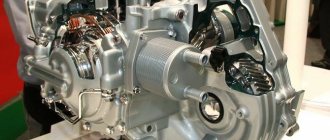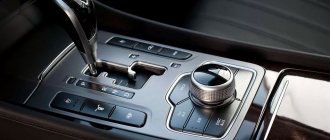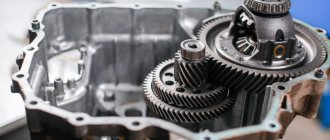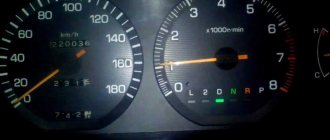Not so long ago, a new era began in the Russian automobile industry. AvtoVAZ finally managed to equip a Russian car with an automatic transmission. The first attempt of the pen was Grant's fret, moving further and further from the usual, unchanging classics. It has technical characteristics increasingly similar to international standards.
When you see Granta, you immediately understand that this is a Russian car. The huge ground clearance, which some crossovers will envy, is perfect for overcoming our Russian roads. A huge trunk for four bags of potatoes, which was appreciated even by the President of Russia. Spacious interior, low price and, in principle, everything you expect from a modern car. Moreover, airbags, traction control and stability control systems, and electrical packages are becoming the norm in the Russian automobile industry.
Lada Granta car with automatic transmission
So, they started installing an automatic machine from Jatco on the Granta. The four-speed hydromechanical JF414E (AY-K3) from the Nissan subsidiary has already been installed on the Nissan Almera, March and other models, and for more than two decades. A fairly reliable hydraulic unit, a simple design without bells and whistles, time-tested, low price - it was not easy to find something similar among Europeans and Americans. The characteristics of the box are quite suitable even for modern cars.
And this is actually very good. Just 20 years ago, those same “Japanese” cars appeared, which a significant percentage of car owners in the eastern part of Russia still drive. It seems that our engineers’ alterations did not spoil anything; the box should last a long time and be resistant to aggressive use and typical mistakes of novice drivers. From 2016, the automatic machine will be available only in the Lux configuration; the remaining Grants will be equipped with a cheaper “robot”. The luxury version will be equipped with a higher-quality audio system, a different instrument panel, electrical accessories, electric power steering, and airbags. Optionally, the Luxury version can receive: ESC system, parking sensors, 15” alloy wheels, seat and belt adjustment, GLONASS system, heated driver’s window, side airbags. Not bad technical characteristics and a number of convenient subtleties compared to the VAZ 2106, for example.
Externally, the Lada Granta with automatic transmission is no different from its mechanized counterpart.
Lada Granta with manual transmission
But in fact - stiffer springs, lower ground clearance and slightly increased fuel consumption - the automatic unit weighs significantly more. For a 16 valve 98 horsepower engine, this automatic is even too “cool” and could withstand a more powerful engine.
What is better for a Lada car, AMT (robot) or automatic transmission (Jatco)?
In August 2012, sales of the Lada Grant with automatic transmission began; it was the first AVTOVAZ car to have an automatic transmission installed as standard on the assembly line. Almost three years later (in March 2015), sales of the Lada Grant with AMT (automated manual transmission) began. Let's talk about the differences between these two transmissions, which can also be installed on Lada Kalina, Priora, Vesta and XRAY. What are their pros and cons, and which car is better to choose?
Advantages and disadvantages of automatic transmission
The Lada Granta/Kalina 2 is equipped with a Jatco automatic transmission; this gearbox has been installed on Nissan for more than two decades and has proven itself well during this time. Reviews from owners of Lada Granta with automatic transmission indicate that the automatic transmission shifts gears smoothly, on time and accurately. There is no excessive thoughtfulness, and sudden accelerations and braking do not confuse her.
The disadvantages of the machine include high fuel consumption, especially in urban areas, as well as very expensive repairs.
Slightly updated interior
We have talked about the Granta salon more than once. There are not many changes in the updated version. The designers redesigned the instrument panel; as a result, the gearbox operation indication has moved and is now displayed above the fuel reserve scale. The shelf on the front panel on the passenger side disappeared from view. Now it is covered by the glove compartment lid. But for some reason the lid of the convenient drawer at the top of the panel is made of plastic in the wrong color, which causes slight irritation. A 12V socket took the place of the cigarette lighter.
There are also nice little things - three headrests in the back row, for example. They are not very high and do not interfere with the view to the rear through the interior mirror. There are hooks on the handles under the ceiling. There is a belt for the middle passenger with a well-thought-out fastening. True, it’s uncomfortable to sit in the back - the Granta remains a cramped car. Only a child or a miniature adult can fit behind the driver. There is a hum in the cabin, which, of course, is annoying. We can only hope that this is a feature of the Grant with its 98-horsepower engine.
Advantages and disadvantages of AMT
“Robot” is installed on a wider range of Lada cars (Granta, Kalina, Priora, Vesta and XRAY) and has a number of operating features. According to AVTOVAZ, the robotic gearbox is distinguished by its simplicity, reliability and efficiency. In addition, the robot is easy to maintain, and its repair cost is practically no different from repairing a manual transmission. Fuel consumption corresponds to that of a manual transmission.
The disadvantages of this transmission are mentioned in reviews of owners of Lada Priora with AMT. An “automatic” changes gears with almost no loss of traction torque, but a “robot” cannot do this. It is this moment that car enthusiasts do not like. In addition, there are discussions about the hum and howl of the AMT.
List of necessary tools for changing oil in manual transmission
To change the oil in a manual transmission, the tools from the table below are required.
Table - Tools and materials required to change the oil in a manual transmission
| Tools and materials | Note |
| Ratchet | Narrow |
| Heads | "at 17", "at 19" |
| Key | "at 13", "at 17", "at 19" |
| Special tool for filling oil | Oil resistant syringe |
| Rags | To clean dirt |
What is the difference between AMT and automatic transmission
| Parameter | AMT or "robot" | Automatic transmission Jatco |
| Surcharge | 25,000 rubles | 50,000 rubles (imported parts) |
| Fuel consumption | less or like a manual transmission | more than a manual transmission by about 1l/100km |
| Clearance | like a manual transmission | because The automatic transmission dimensions are larger, the ground clearance is 2 cm less |
| Maintainability | like a manual transmission | not officially provided |
| Gear shift | only felt when shifting to a higher gear (during acceleration) | not noticeable either when accelerating or decelerating |
| Availability of manual mode | There is | No |
| Kickdown function | There is | There is |
| Adaptation to driving style | yes (more than 20 cards) | No |
Both transmissions make driving easier, which significantly reduces driver fatigue, especially in traffic jams.
What transmission do you recommend for Lada cars? Let us remember that cable “mechanics” are famous for their howling.
Source
Automatic transmission "Lada Granta": appearance, principles of operation, testing and repair
The Lada Granta automatic transmission has 6 operating modes: forward, reverse, neutral, parking, and also forward with a limit of up to 2 gears. The control system consists of sensors that read all vehicle parameters, an ECU and performers - solenoids. Actuators change gears using servos.
The automatic transmission on the Lada Granta is represented by a VAZ-2182 robotic gearbox and a Jatco hydraulic automatic transmission. In the reviews, robot owners disagreed, discussing the advisability of purchasing Granta with AMT. The Lada Granta automatic transmission received a lot of positive feedback. Its main disadvantage is increased fuel consumption (unlike the Lada Granta with a manual transmission).
What boxes were installed on different car models
The automatic version of the Lada Granta was launched in 2012. The robotic gearbox was developed in 2014, the first “Grant” with manual transmission appeared in 2015.
Robot
The 5-speed AMT VAZ-2182 can be found on Grants with 16-valve engines under the hood. The robot was installed on Granta on different body types in different years:
- sedan - since 2015;
- hatchback, station wagon, liftback - from 2022;
- "Cross" - from 2022.
Machine
The Japanese automatic is installed on Lada Granta varieties with a 16-valve engine in the body:
- sedan - since 2012;
- liftback - since 2014;
- hatchback, station wagon, “FL” - from 2022.
AvtoVAZ engineers sought to find a cheap and reliable automatic transmission. The Japanese development of Jatco – JF414E – was chosen. It was not immediately possible to reconcile the 4-speed with the domestic engine. The help of Austrian colleagues was needed. Through the joint efforts of AvtoVAZ and AVL engineers, it was possible to integrate Jatco into the Lada system and speed up the operation of the gearbox.
Features of automatic transmission on Lada Granta
Automatic transmissions "Grants" differ in design and operating mechanism.
Robot design
- clutch engagement actuator (the unit includes a clutch fork rod, an electric motor, a drive gear, a wear compensator and a compensation spring);
- gear shift mechanism (consists of a rod, two electric motors, gear shift and gear selection drives);
- clutch fork;
- speed sensor;
- selector knob.
The model used with a single clutch disc is considered obsolete. Manufacturers of foreign cars have switched to preselective robots, the design of which includes 2 clutches.
Hydraulic automatic machine design
The 4-speed is based on the development of the Nissan REF403A. Japanese engineers modernized the model: they made the machine more powerful, reduced weight and production costs. The transverse hydraulic automatic is designed for installation on a front-wheel drive passenger car with an engine capacity of no more than 1.6 liters. The automatic transmission design has 4 units:
- torque converter - a unit that ensures the transmission of torque from the engine to the input shaft;
- control valve block - consists of various sensors, solenoid valves and an ECU module;
- planetary part - consists of two planetary gears, allowing for 4 speeds, among the components of the unit are 3 multi-disc clutches, a multi-disc brake, an overrunning clutch and a brake band;
- clutches and brake mechanisms - clutch elements responsible for selecting gears and switching between speeds;
- pump - supplies working fluid to the torque converter and other components.
Jatco engineers have provided protection against driver errors. The electronic unit prevents incorrect manual gear shifting. If the car is moving forward, then it will not be possible to engage reverse. A separate system analyzes the temperature of the unit and signals when there is unacceptable overheating.
Specifications
The AvtoVAZ robotic gearbox operates in 4 modes: automatic, reverse, neutral, manual control. When choosing the latter option, the driver changes gears independently, while the clutch is controlled by the computer. The robot can change from manual mode to automatic if the engine accelerates to high speeds that could damage the transmission.
Automatic transmission
The Lada Granta automatic transmission has 6 operating modes: forward, reverse, neutral, parking, and also forward with a limit of up to 2 gears. The control system consists of sensors that read all vehicle parameters, an ECU and performers - solenoids. Actuators change gears using servos.
The machine parameters have changed. The installation of an automatic transmission on the Lada Granta led to a change in ground clearance (up to 140 mm from the standard 160 mm). The weight of the car increased, which resulted in the adjustment of the shock absorber springs (changed to stiffer ones). The trunk volume remains the same – 480 liters.
Service details
The instructions for the VAZ-2182 contain a recommendation to change the oil every 75 thousand kilometers. From the factory, the box is filled with Rosneft Kinetic Service 75W85 GL-4 with a volume of 2.25 liters.
The Lada Granta automatic transmission is considered one of the most unpretentious automatic transmissions, but it also requires timely maintenance: checking the level of the filled transmission, changing the oil and oil filter (although, according to the manufacturer, the transmission fluid will be enough for the entire service life of the box). According to the recommendations of the official dealer, the oil needs to be updated every 60 thousand kilometers.
During the replacement process, the technician assesses the condition of the hydraulic machine. If there is a large amount of metal shavings on the magnets, it is worth carrying out a major overhaul of the unit. It may happen that a complete oil change will “kill” the machine, so it is better to disassemble the box and check the integrity of the internal components. The technician must remove the box, disassemble the assembly, replace clutches, seals and gaskets and other worn or damaged elements. The JF414E hydraulic unit fails in exceptional cases; its flushing is required extremely rarely.
From the factory, the automatic transmission is filled with Nissan ATF Matic-S or Genuine EJ-1 transmission fluid. When replacing, it is better to buy the same oil, although JF414E is tolerant of other compounds. The total oil volume is 5.4 liters; a partial replacement will require 3 liters of fluid. Together with the transmission, the coarse filter and the pan gasket of the Grants gearbox are changed.
If the car's computer begins to signal errors, you need to carry out diagnostics. To do this, the Lada Granta is driven to a showroom or car service center. You can take readings yourself. To do this you will need an on-board computer – multitronics. Some “Grants” configurations are equipped with it from the factory. Not everyone likes the standard device installed in the console, as it has limited functionality. Car owners buy and install multitronics with a color display and a wide range of options.
Fuel consumption by automatic transmission on Grant
The efficiency of the car depends not only on the engine power, but also on the type of transmission box. Consumption of 95 gasoline for cars with different types of transmissions and installed engines is presented in Table 1.
Gearbox comparison
Table 1. Fuel consumption of Lada Granta
| Gearbox type | Engine volume and power | Combined cycle fuel consumption per 100 km, l |
| Manual transmission | 1.6 l, 106 hp | 6,5 |
| 1.6 l, 87 hp | 6,8 | |
| Manual transmission | 1.6 l, 106 hp | 6,5 |
| Automatic transmission | 1.6 l, 98 hp | 7,2 |
The data given in the table are factory data, i.e. obtained as a result of a test, and not in real conditions. Actual consumption depends on the weight of the loaded vehicle, road conditions, driving style and usually deviates upward. According to owners' reviews, in winter, when the car is warmed up and when driving mainly in the city, up to 16 liters of fuel can be consumed per 100 km.
Characteristics of automatic transmission
The idea of installing an automatic transmission on the Lada came to AvtoVAZ back in 2010, but was realized only in 2011. A long-term contract was signed with the Japanese company Jatco, which is famous for the quality of its variators and hydraulics.
The box is not the best in terms of technical parameters, but it has been tested on other models for several years. We can safely say that all weak points are known, as well as ways to eliminate them.
From 2006 to 2010, Jatco was installed on Nissan Note cars. Numerous reviews from owners are positive based on the results of operating the unit.
Installation of the machine was difficult, since specialists needed to make more than 30 settings and adjustments. Rumor has it that craftsmen from Austria took part in the calibration process.
The box has very good ergonomics. The handle (link) is of optimal height, fits comfortably in the hand. The selective part is equipped with icons for visualization. The mode is duplicated directly on the dashboard.
At the same time, the locking of the lever in one position is uncertain. There are several operating modes of the machine:
You can “forget” about switching to third gear if the oil has not warmed up above 15°C. The fourth is activated at 60°C.
It is important to know. The design of the power plant does not have a flywheel, instead it is a drive disk.
Due to the transmission housing, the ground clearance was reduced by 1.5 cm. The automatic transmission control unit is located on the left front side, behind the optics. Many car owners express dissatisfaction about this, since in the event of a head-on collision, the risk of damage to the module is 100%.
The automatic operating modes are configured for driving in the city, on highways, in the countryside; to a lesser extent, the box is adaptive for driving on country roads. The noise level is minimal.
Pros and cons of “Grants” with automatic transmission
Both boxes have their advantages and disadvantages. The automatic is more reliable, but more gluttonous. The robot consumes less fuel, but driving the VAZ-2182 is uncomfortable.
Pros and cons of the robot
The outdated single-clutch design has many disadvantages:
- Lack of comfort. Gear shifting is not smooth enough. Owners of Granta with a robot complain about jolts during acceleration.
- Slow operation of the box. Speed changes occur with a delay.
- Unreliable, the service life with careful driving hardly reaches 200 thousand km.
- Afraid of slipping.
- When the movement begins, a rollback occurs.
- No rolling mode. The automatic movement implemented in the automatic transmission was loved by the townspeople. Standing in a traffic jam, the driver just needs to release the brake pedal, and the car begins to roll forward. The robot will not move until the gas is pressed.
The VAZ-2182 has fewer advantages than disadvantages. The electrically controlled robot itself is inexpensive, and the main positive feature is low fuel consumption. Servicing a manual transmission is almost the same as for mechanics. Repairing a robot is cheaper than rebuilding an automatic transmission.
Pros and cons of a hydraulic automatic machine
A positive feature of the JF414E is its reliability and simplicity of design. The automatic feels equally good on the highway and on a dirt road. Another advantage is the relatively small size and weight of the unit. The hydraulic automatic machine is easy to maintain without requiring large expenses. At an official Lada dealer, the automatic transmission cannot be repaired; in case of failure, the entire unit is replaced. A new JF414E box costs about 100 thousand rubles; on Avito and car dismantling sites you can buy a restored unit for 2 times cheaper.
There are few negative reviews about the operation of the hydraulic automatic machine. Some owners complain that the Lada Granta automatic transmission lacks fifth gear. They note higher fuel consumption than the Lada Granta with manual transmission.
Due to its age, a time-tested design also has a negative side - many modern engineering solutions do not fit into an outdated unit. The 4th mortar is thoughtful and leisurely in its work. The weakest component of the JF414E is the ECU board. The part does not tolerate power surges and is very demanding on the quality and temperature of the oil. Lada Granta with hydraulic automatic transmission cannot be skidded.
Scheme of work
The clutch assembly is located between the power unit and the transmission. When you press the clutch pedal, the connection between the engine and the wheels is broken. At this moment, the driver activates the desired gear to continue driving.
“Mechanics” is a metal case, inside of which there are shafts and gears. One gear is rotated by a motor, the other transmits rotational motion to the wheels.
Gear shifting occurs using a lever (slide), which is located inside the car.
Note to the driver! First and reverse gears have the most power but the lowest speed.
In a manual transmission, the gear travel is significantly reduced compared to the traction mechanism. The location of the switching block (module) makes it possible to minimize the dependence of the transmission on the ambient temperature and the operating temperature of the engine.
In the 2181 series box, it was possible to significantly increase the service life by reducing possible oil leakage points. Two sealing glands instead of the previous four.











